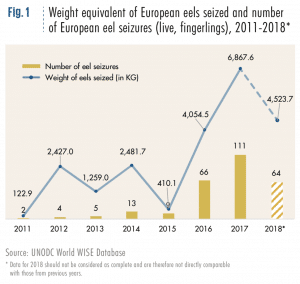Safeguarding eels through international cooperation
UNODC World Wildlife Crime Report 2020 features eel trafficking
LET'S MAKE A DIFFERENCE
HELP US SUPPORT THE EEL'S RECOVERY
LET'S MAKE A DIFFERENCE
HELP US SUPPORT THE EEL'S RECOVERY
Join the SEG Mailing List


 At this point in time, every European glass eel imported for the purposes of farming requires a CITES certificate to export, as should every adult European eel exported after being grown out. Interviews with aquaculture specialists indicate that one kilogram of European glass eels yields 750 kilograms of filet. If so, it should be possible to reconcile glass eel imports with eel meat exports. Even taking into account the gap between introduction and harvest, it is unclear how such large exports of European eel meat would be possible given the low quantities of reported European glass eel imports (Figure 17). This suggests that glass eels were imported without CITES certification. In 2017, eel meat exports were commensurable with expected production, but this would only be possible if all European eel meat were exported and none retained for the domestic market. Additional, though incomplete, data reported to the CITES Animals Committee suggest that only 4.5 MT of European glass eels may have been introduced into Chinese cultivation ponds between 2011 and 2017. Teamed with the seizure data, which indicate the majority of intercepted shipments were destined for China, these trade data provide evidence of a sizable illegal flow.“
At this point in time, every European glass eel imported for the purposes of farming requires a CITES certificate to export, as should every adult European eel exported after being grown out. Interviews with aquaculture specialists indicate that one kilogram of European glass eels yields 750 kilograms of filet. If so, it should be possible to reconcile glass eel imports with eel meat exports. Even taking into account the gap between introduction and harvest, it is unclear how such large exports of European eel meat would be possible given the low quantities of reported European glass eel imports (Figure 17). This suggests that glass eels were imported without CITES certification. In 2017, eel meat exports were commensurable with expected production, but this would only be possible if all European eel meat were exported and none retained for the domestic market. Additional, though incomplete, data reported to the CITES Animals Committee suggest that only 4.5 MT of European glass eels may have been introduced into Chinese cultivation ponds between 2011 and 2017. Teamed with the seizure data, which indicate the majority of intercepted shipments were destined for China, these trade data provide evidence of a sizable illegal flow.“